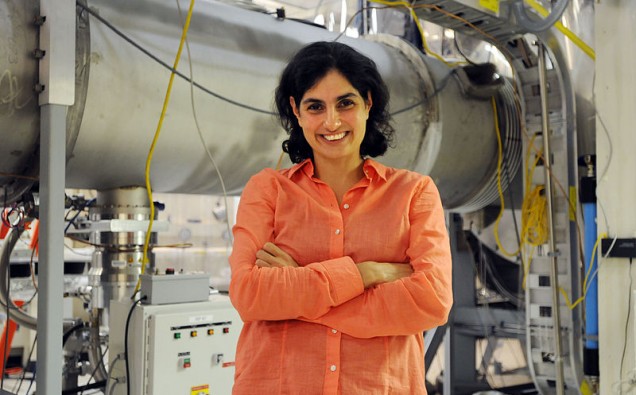
Two Pakistanis were members of the team of scientists and engineers that discovered gravitational waves in the fabric of space and time, confirming Albert Einstein’s general theory of relativity, and heralding new era of uncovering mysteries of cosmos.
Nergis Mavalvala, 47, who was born in Karachi and started studying gravitational waves during her graduation at the Massachusetts Institute of Technology (MIT). The Pakistani-American professor is one of the leading scientists to have persistently pursued the project in the United States.
The other Pakistani is Imran Khan, a 25-year-old scientist, who is from Quetta, Balochistan, and is a PhD candidate at Italy’s Gran Sasso Science Institute (GSSI), one of the institutions involved in the research.While Dr. Nergis Mavalvala, Professor of Astrophysics, is already a well-known figure, young Imran Khan received media spotlight only on Monday.
The news of two Pakistani scientists being part of the momentous discovery of gravitational waves has been sweeping across Pakistani airwaves and newspapers since last Thursday, with messages of felicitation emanating from top leadership and jubilation in the scientific community.
In the United States, Pakistani-Americans welcomed the news that two scientists of Pakistani origin contribute to the tremendous scientific advancement.
The breakthrough is a milestone for American and world scientists, after years of investment and commitment to the LIGO project, one of the largest funded missions by the National Science Foundation. Britain’s Science and Technology Facilities Council, Germany’s Max Planck Society and Australian Research Council have also contributed to the mammoth LIGO project.
Announced last week, the epoch-making discovery of gravitational waves – already hailed as discovery of the century – means the scientists have detected gravitational waves reaching earth. A study of the waves will reveal about their “dramatic” origins and about the nature of gravity that cannot otherwise be obtained.
“Physicists have concluded that the detected gravitational waves were produced during the final fraction of a second of the merger of two black holes to produce a single, more massive spinning black hole. This collision of two black holes had been predicted but never observed,” a statement by Laser Interferometer Gravitational-wave Observatory (LIGO) said.
According to LIGO, the gravitational waves were detected on September 14, 2015 at 5:51 a.m. Eastern Daylight Time (09:51 UTC) by both of the twin LIGO detectors, located in Livingston, Louisiana, and Hanford, Washington, USA.
“This is an exciting and unforgettable moment: I have spent 35 years of my life in this research”, GSSI’s director Eugenio Coccia said in a statement.
“Detecting gravitational waves and proving the existence of black holes all in once is wonderful. Humanity has now a new sense: from now on we will not only see the cosmos, but also listen to its vibrations, its music.”
According to the Institute’s website in all the LIGO endeavor involved 1004 researchers belonging to 133 scientific institutions all over the world.
Meanwhile, academics, scientists and engineers and students in Pakistan have embraced the news as a morale booster for the nation, grappling with security challenges.
In the past, Pakistan produced some of the greatest names in the field of physics including Nobel Laureate Dr. Abdul Salam. In America, Dr. Ayub Ommaya invented the Ommaya Reservoir, which is used to treat brain tumors.
Born to a Parsi family in Karachi, Mavlavala got her early education in the mega port city, and since her school days, she has been an avid learner, researcher, scientist and teacher. She came to the United States as teenager.
According to her MIT research page, Prof. Mavlavala’s work focuses on making instruments called interferometers that are “sensitive enough to detect gravitational waves.”
“So why should we look for these faint and elusive gravitational waves? Directly detecting gravitational waves will open a new window to further our understanding of Universe. Gravitational waves will tell us about Black Holes that gobble up light, but radiate gravitational waves, and about the earliest moments after the Big Bang, when light could not escape the birth throes of the Universe,” she tells readers of her page, provoking curiosity into the research.
In an article, four years ago, Science magazine, noted that Mavalvala has passed her “infectious enthusiasm” for her work to many students. According to the magazine Mavalvala saw herself a product of good mentoring.
“From the chemistry teacher in Pakistan who let her play with reagents in the lab after school to the head of the physics department at MIT, who supported her work when she joined the faculty in 2002, she has encountered several encouraging people on her journey,” writer Vijaysree Vankatraman remarked in a comprehensive article.
The other Pakistani, Imran Khan is a graduate of National University of Computer and Emerging Sciences, Peshawar campus. The NUCES was established by Foundation for Advancement of Science and Technology, and is considered a premier institution.
Khan is researching at Italian Gran Sasso Science Institute (GSSI), which contributed to LIGO project with 8 coauthors, six of which are young researchers from Italy, China, India and Pakistan.
“It was great to get selected among hundreds of applicants for the Marie Curie initial training network program ‘GraWIToN’ to become part of the European team involved with the discovery of gravitational waves,” Imran Khan told Pakistani Dawn newspaper, describing his mother as the inspiration behind his work.














Pakistanis hold innovative and creative qualities for scientific thinking and research ,we should be proud of two youngsters who have part of gravitational wave discovery team .